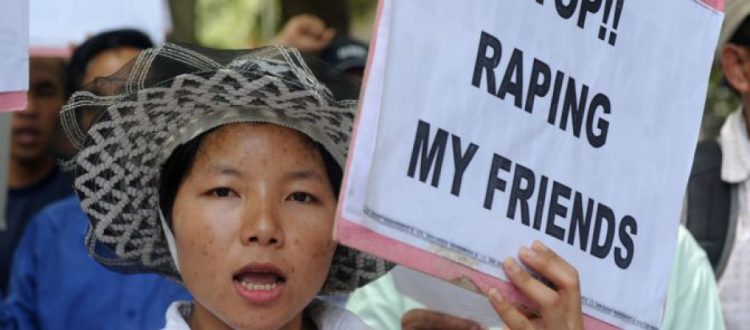Myanmar – rape as a military policy
The Association of World Citizens has called attention to the use of rape as an instrument of war in the U.N. human rights bodies in Geneva since the time of the armed violence in former Yugoslavia. Rape is now recognized by the U.N. as a war crime and is one of the charges that can be brought to the International Criminal Court in the Hague. In practice, there are few convictions either at the national or the international level. Thus there must be an emphasis on the conscience of the individual soldier and his commanders that rape as a policy is morally wrong as well as illegal under international law.
| Suggested Reading | Conflict Background | GCCT |
By Rene Wadlow
Pramila Patten, the United Nations Envoy on Sexual Violence in Conflict, in her 16 April 2018 presentation to the U.N. Security Council highlighted the role of the Myanmar armed forces (the Tatnadaw) and their Buddhist militia allies of systematic rape of Rohingya women in Rakhine State. Rape, she said, had been used as a “calculated tool” to strike terror. There were many cases of gang rape as well as abduction of women for sexual slavery in army camps. Most of the victims were women concentrated in rural areas where there is little relevant medical or recovery services in the best of times.
This is not the first time that there has been sectarian violence in Arakan. In December 1991, there was a massive flight of Rohingyas (the name given to the Islamic community in Arakan, now used by themselves as well) to Bangladesh. The inhabitants of Arakan are divided at least into two major groups — the Muslim Arakanese (Rohingyas) and the Buddhist Arakanese (Rakhines). While there are divisions within each of the two groups, when there is violence, each community closes in on itself, and there are few individuals who are “bridge-builders”. It is estimated that there are now some one million Rohingyas living in Bangladesh as refugees but population statistics are weak. While there are a good number of NGOs in Bangladesh, the country as a whole is poor, and help to refugees is not a major priority.
Now there is danger that sectarian violence spreads to other parts of Myanmar taking unless real measures are taken to build bridges between the communities Myanmar has known ethnic conflict almost from Independence with ethnic groups — the Karen, Kachin, Mon and others — creating armed groups and fighting for greater autonomy or for the creation of an independent country. There is also wide agreement among the inhabitants of Arakan that they wish greater autonomy from the Central Government. In the late 1940s, with left-over weapons abandoned by the Japanese soldiers who had occupied the area, there was an armed revolt, first against the British and shortly after Independence, against the Buddhist-led Burmese government. The Rohingya militia was led by the Mujahid Bahimi (Army of the Religious Volunteers) with internecine leadership struggles with the Jihad Council. Since that time on, there have been Muslim-led armed movements, particularly active during the 1970s and early 1980s — always met by Army repression. Although an Islamic vocabulary was used, the basic aim of the Arakan movements was for autonomy and was not hostile to local Buddhists.
The Myanmar Government has long experience in dealing with ethnic conflicts — a mixture of repression and negotiated cease-fires —, but religious sectarian tensions are something relatively new. There has been a religious element to the ethnic conflicts. Much of the ethnic leadership, especially among the Karen, is Christian — Baptist and Seventh Day Adventists —, but the conflict was for autonomy and could not really be called sectarian.
Now, there are attacks against Muslims – as Muslims. Except for the Rohingyas, who largely came from Bengal and live in fairly compact communities, Muslims elsewhere are often small shop keepers and live in a dispersed way, thus vulnerable to mob violence.
While there is a police protection dimension to sectarian conflict resolution, the basic steps for reconciliation and training for conflict resolution must come from within the Buddhist community as by far the more numerous and powerful and especially from monks who hold positions of respect and authority.
The ethics of non-violence are central to Buddhism. Monks, members of the Sangha, have special responsibilities to respect freedom of thought and individual development as set out in the Kalama Sutta “ Oh, Kalamas, when you know for yourselves that certain things are unwholesome, wrong, and bad, then give them up…And when you know for yourselves that certain things are wholesome, right, and good, then accept them and follow them”.
In history, there have been many occasions when monks have sought to protect the weak from extortion and oppression and to intervene in conflicts. Such actions are part of the fundamental duty of the monk to alleviate suffering by indicating the correct moral path and expressing universal compassion. Monks have greatly influenced the general tone of government policy, although not so much its details.
The Association of World Citizens has called attention to the use of rape as an instrument of war in the U.N. human rights bodies in Geneva since the time of the armed violence in former Yugoslavia. Rape is now recognized by the U.N. as a war crime and is one of the charges that can be brought to the International Criminal Court in the Hague. In practice, there are few convictions either at the national or the international level. Thus there must be an emphasis on the conscience of the individual soldier and his commanders that rape as a policy is morally wrong as well as illegal under international law.
Rene Wadlow is president of the Association of World Citizens
The views expressed in this article do not necessarily reflect the views of TransConflict.
Interested in writing for TransConflict? Contact us now by clicking here!



















